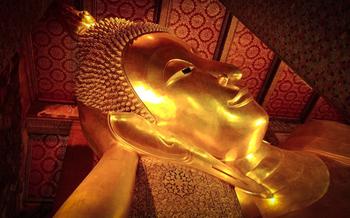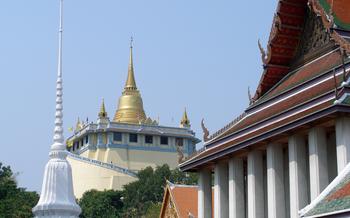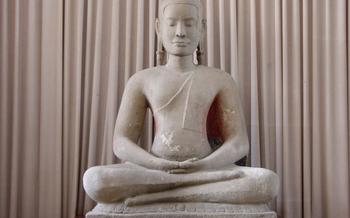
Khao Kong Buddhist Park
- The Khao Kong Buddhist Park: A Stunning Spiritual Destination
- Exploring the Grand Buddha Image
- The Emerald Buddha Replica: A Sacred Replica
- The Chedi and Stupas: Symbols of Buddhist Faith
- The Sacred Relics: A Glimpse into the Past
- The Museum: A Journey Through History
- The Natural Surroundings: A Sanctuary for Wildlife
- The Local Community: A Warm Welcome
- The Best Time to Visit: Ideal Weather Conditions
- Getting There: Convenient Transportation Options
- Accommodation: A Range of Choices
- Food and Drink: Local Delights
- Things to Do Nearby: Exploring the Region
- Insider Tip: Hidden Gems and Photography Opportunities
The Khao Kong Buddhist Park: A Stunning Spiritual Destination
Nestled amidst the serene landscapes of Narathiwat, Thailand, the Khao Kong Buddhist Park stands as a testament to the region's rich cultural heritage and spiritual traditions. Established in 1982, this park is not just a place of worship but also a sanctuary for tranquility and reflection. Its unique architectural features, stunning natural beauty, and profound religious significance make it a must-visit destination for travelers seeking a spiritual and cultural immersion.
The park's design is a harmonious blend of traditional Buddhist architecture and modern elements, creating a captivating visual experience. Visitors are greeted by a majestic 70-meter-tall Buddha image atop a hill, symbolizing the Buddha's teachings and enlightenment. The park also features a replica of the revered Emerald Buddha, housed within a serene temple, attracting pilgrims and visitors alike.
The Chedi and Stupas, with their intricate designs and religious symbolism, offer a glimpse into the rich history of Buddhism in Thailand. The park's numerous salas and meditation areas provide tranquil spaces for visitors to find inner peace and practice mindfulness, immersing themselves in the serenity of the surroundings.
The Khao Kong Buddhist Park is not just a religious site; it is a testament to the region's artistic and cultural heritage. The park's museum showcases a collection of artifacts, relics, and historical exhibits, providing visitors with a deeper understanding of the park's significance and the cultural traditions of Narathiwat.
Exploring the Grand Buddha Image
In the heart of Khao Kong Buddhist Park, a majestic spectacle unfolds - the Grand Buddha Image. Standing tall atop a hill, this colossal statue emanates an aura of serenity and devotion. Its sheer size, reaching an awe-inspiring height, is a testament to the craftsmanship and artistry that went into its creation. The image of Lord Buddha exudes an air of tranquility, with his eyes gently closed in meditation and a faint smile gracing his lips.
The positioning of the Grand Buddha Image is a deliberate choice that enhances its grandeur. Perched atop a hill, it seems to survey the surrounding landscape, blessing all who come to pay homage. The elevated vantage point offers visitors breathtaking views of the park and the surrounding countryside, creating a truly immersive experience.
Beyond its aesthetic appeal, the Grand Buddha Image holds deep religious significance for Buddhists. It serves as a reminder of the Buddha's teachings and his path to enlightenment. Devotees come from far and wide to offer prayers, seek blessings, and find solace in the presence of this sacred figure.
Exploring the Grand Buddha Image is a journey of spiritual discovery, artistic appreciation, and awe-inspiring natural beauty. Whether you're a devout Buddhist or simply a curious traveler, this iconic landmark is guaranteed to leave a lasting impression.
The Emerald Buddha Replica: A Sacred Replica
Within the Khao Kong Buddhist Park, a sacred replica of the Emerald Buddha, Thailand's most revered Buddha image, holds a place of great importance. This replica, meticulously crafted with exquisite detail, captures the essence and beauty of the original, which resides in the Grand Palace in Bangkok. Enshrined in its own dedicated pavilion within the park, the Emerald Buddha replica draws countless devotees and visitors seeking blessings and spiritual connection.
The replica stands as a testament to the deep devotion and respect Thai people hold for the Emerald Buddha. Visitors can witness the intricate craftsmanship and artistry that went into creating this replica, which mirrors the original in both form and symbolism. The serene expression, adorned with precious jewels, radiates a sense of tranquility and reverence that captivates all who behold it.
Offerings of flowers, incense, and gold leaf are made by devotees as a form of devotion and to seek blessings. The replica serves as a powerful symbol of faith, reminding visitors of the teachings of Buddha and the importance of cultivating inner peace and compassion. Whether seeking spiritual guidance or simply marveling at the exquisite craftsmanship, the Emerald Buddha replica is a must-see attraction within the Khao Kong Buddhist Park.
The Chedi and Stupas: Symbols of Buddhist Faith
The Khao Kong Buddhist Park is home to a collection of chedis and stupas, which are iconic Buddhist structures that hold deep religious and symbolic significance. These majestic monuments vary in size, design, and architectural styles, each representing a different aspect of Buddhist faith and history.
The chedis, also known as stupas, are tall, bell-shaped structures that symbolize the Buddha's teachings and the path to enlightenment. They are often adorned with intricate carvings, sculptures, and colorful tiles that depict scenes from the Buddha's life and Buddhist cosmology. The chedis at Khao Kong are particularly impressive, standing tall and radiating an aura of serenity and spirituality.
The stupas, on the other hand, are smaller, dome-shaped structures that typically contain relics or remains of revered Buddhist figures or saints. These sacred objects are believed to hold great spiritual power and are often visited by pilgrims and devotees seeking blessings and protection. The stupas at Khao Kong are carefully preserved and venerated, serving as a reminder of the rich Buddhist heritage of the region.
Throughout history, chedis and stupas have played a crucial role in Buddhist practices and rituals. They are used for meditation, prayer, and offerings, and are often circumambulated by devotees as a sign of respect and devotion. The chedis and stupas at Khao Kong are no exception, serving as focal points for spiritual practices and attracting visitors from all over the world who seek inner peace and connection with the divine.
The Sacred Relics: A Glimpse into the Past
The Khao Kong Buddhist Park is home to a collection of sacred relics that hold immense significance in the Buddhist faith. These relics, believed to be fragments of the Buddha's body or personal belongings, are revered by devotees as tangible connections to the enlightened one. Visitors can witness these precious artifacts, which are carefully preserved and displayed within the park's sacred chambers.
The types of relics found at the park vary, with some being bone fragments, hair strands, or teeth. Each relic is accompanied by detailed descriptions and historical context, providing visitors with insights into the life and teachings of the Buddha. The discovery of these relics is often shrouded in mystery and folklore, adding to their allure and spiritual significance.
Buddhists believe that relics possess a powerful energy that can bring blessings, protection, and good fortune. Devotees often pay homage to the relics by offering prayers, flowers, and incense. The presence of these sacred objects creates a palpable sense of reverence and devotion within the park, making it a truly spiritual destination.
The Museum: A Journey Through History
The Khao Kong Buddhist Park also houses a museum that delves into the rich history and significance of the park. Visitors can embark on a journey through time as they explore exhibits showcasing artifacts, relics, and documents that tell the story of the park's origins, construction, and the religious and cultural significance it holds.
The museum's displays provide insights into the park's architecture, the symbolism behind its various structures, and the role it has played in the lives of local communities. Visitors can marvel at ancient artifacts, learn about the park's restoration efforts, and gain a deeper understanding of the Buddhist traditions and beliefs that have shaped this sacred space.
Interactive displays and educational resources enhance the museum experience, making it an engaging and informative journey for visitors of all ages. Whether you're a history buff, a religious enthusiast, or simply curious about the cultural heritage of Thailand, the museum at the Khao Kong Buddhist Park promises a captivating and enlightening experience.
The Natural Surroundings: A Sanctuary for Wildlife
The Khao Kong Buddhist Park is not only a spiritual sanctuary but also a haven for a diverse array of flora and fauna. The park's lush greenery provides a habitat for numerous bird species, including hornbills, parrots, and woodpeckers, whose melodious calls fill the air. Visitors can also spot various reptiles, amphibians, and insects, adding to the park's rich biodiversity.
Conservation efforts are a priority at the Khao Kong Buddhist Park, with initiatives in place to protect and preserve the natural environment. The park's management works closely with local communities to ensure sustainable practices and minimize human impact on the ecosystem. Visitors are encouraged to respect the wildlife and refrain from disturbing their natural habitats.
Scenic walking trails meander through the park, offering visitors the opportunity to immerse themselves in the beauty of the natural surroundings. These trails provide glimpses into the diverse flora and fauna, with informative signs along the way to educate visitors about the local ecosystem.
It is essential to remember that the Khao Kong Buddhist Park is a sacred space, and visitors should conduct themselves respectfully. Avoiding loud noises, littering, and disturbing the wildlife helps maintain the serene atmosphere and protects the delicate balance of the ecosystem. By embracing eco-friendly practices, visitors can contribute to preserving the natural wonders of the park for generations to come.
The Local Community: A Warm Welcome
The people of Narathiwat are renowned for their warm hospitality and friendly nature, extending a heartfelt welcome to visitors from all corners of the globe. Immerse yourself in the vibrant local culture by engaging with the community members, who are eager to share their traditions and way of life. Participate in cultural workshops, savor delicious homemade cuisine, and learn about the unique customs and beliefs that shape the identity of this vibrant region.
Support local businesses and initiatives by purchasing souvenirs from artisan markets, dining at family-run restaurants, and utilizing the services of local guides and tour operators. Your patronage not only contributes to the economic well-being of the community but also fosters meaningful connections and cultural exchange. Embrace the opportunity to learn from the locals, ask questions, and gain insights into their perspectives, creating a mutually enriching and memorable experience for both visitors and residents alike.
The Best Time to Visit: Ideal Weather Conditions
The Khao Kong Buddhist Park is a year-round destination, but certain times of the year offer the most pleasant weather conditions. The best time to visit is during the cool and dry season, which runs from November to February. During this period, the temperatures are mild, the humidity is low, and there is little to no rain. This makes for ideal conditions for exploring the park and enjoying the outdoor activities.
It is important to note that the park can get quite hot and humid during the summer months (March to May). While it is still possible to visit during this time, it is advisable to plan accordingly and take precautions to stay hydrated and cool. The rainy season (June to October) also brings its own challenges, as heavy rainfall can make some areas of the park inaccessible and disrupt outdoor activities.
To avoid the crowds and make the most of your visit, it is recommended to plan your trip during the shoulder months (October and March). During this time, the weather is still favorable, but there are fewer tourists, allowing you to enjoy a more peaceful and intimate experience.
Getting There: Convenient Transportation Options
Reaching the Khao Kong Buddhist Park is a breeze, with multiple transportation options available. Whether you prefer the convenience of a private vehicle, the flexibility of public transport, or the ease of air travel, getting to the park is hassle-free.
If driving, simply follow the well-maintained roads leading to the park. For those arriving by air, the nearest airport is Narathiwat Airport, which is approximately a 30-minute drive away. From the airport, you can easily hire a taxi or rent a car for a scenic journey to the park.
Public transportation is another viable option, with regular buses departing from major cities like Bangkok and Hat Yai. These buses offer a comfortable and affordable way to travel, dropping you off right at the park's entrance.
No matter your preferred mode of transport, getting to the Khao Kong Buddhist Park is a convenient and straightforward experience, allowing you to immerse yourself in the serene ambiance of this spiritual sanctuary without any hassle.
Accommodation: A Range of Choices
For those seeking accommodation near the Khao Kong Buddhist Park, a range of options awaits. Whether you prefer the comfort of a hotel or the local charm of a guesthouse, there's something to suit every budget and preference. Several hotels are conveniently located within walking distance of the park, offering modern amenities and comfortable stays. For a more immersive experience, consider homestays that provide a unique opportunity to connect with the local community and learn about their way of life. If you plan on an extended stay or a spiritual retreat, guesthouses and meditation centers offer longer-term accommodations and serene environments conducive to reflection and inner peace.
To find the ideal accommodation, consider factors such as proximity to the park, desired amenities, and budget. Advance booking, especially during peak tourist season, is recommended to secure your preferred choice. Whether you seek a luxurious retreat or a simple, comfortable stay, you'll find suitable options near the Khao Kong Buddhist Park, ensuring a convenient and enjoyable visit.
Food and Drink: Local Delights
In the vicinity of the Khao Kong Buddhist Park, a delectable array of culinary experiences awaits. Authentic Thai cuisine, renowned for its vibrant flavors and aromatic spices, is a must-try. Indulge in classic dishes such as "Pad Thai", stir-fried rice noodles with a tangy tamarind sauce, or savor the rich, creamy flavors of "Massaman Curry", a fragrant blend of coconut milk, peanuts, and tender beef.
For those seeking vegetarian or vegan options, the park's surroundings offer a plethora of choices. Local markets and restaurants cater to diverse dietary preferences with an array of fresh produce, meat alternatives, and traditional Thai dishes adapted for plant-based diets.
To fully immerse yourself in the local culinary scene, venture beyond the park and explore the nearby towns and villages. Sample the delectable street food offerings, from grilled meats and seafood to sweet and savory treats. Don't miss the chance to try "Roti Mataba", a crispy flatbread filled with a sweet or savory filling, or indulge in the tropical flavors of "Khanom Chan", a steamed coconut dumpling.
As you savor the local cuisine, engage with the friendly vendors and locals, who are always eager to share stories and recommendations. Embrace the opportunity to learn about the region's rich culinary heritage and discover hidden gems that only the locals know about.
Things to Do Nearby: Exploring the Region
While the Khao Kong Buddhist Park is the main attraction in Narathiwat, there are several other enticing destinations within reach. For those interested in history and culture, the nearby town of Sai Buri offers a glimpse into the region's past with its ancient ruins and historical sites. Visitors can explore the remnants of ancient fortifications, marvel at centuries-old temples, and delve into the fascinating local museum to uncover the rich heritage of Narathiwat.
Nature enthusiasts will find solace in the stunning Wao National Park, renowned for its cascading waterfalls, lush rainforests, and diverse wildlife. With a network of well-maintained trails, visitors can embark on invigorating hikes, spot exotic birds, and immerse themselves in the tranquility of the natural surroundings.
For those seeking a unique experience, a visit to the Laem Pho Cape is a must. This picturesque headland boasts breathtaking views of the Andaman Sea, pristine beaches, and a charming lighthouse that adds to its allure. Visitors can spend a relaxing day swimming, sunbathing, or simply reveling in the coastal beauty.
These are just a few of the many attractions that await in the vicinity of the Khao Kong Buddhist Park. By venturing beyond the park's boundaries, travelers can gain a deeper understanding of the region's rich cultural heritage, immerse themselves in the natural wonders of Narathiwat, and create lasting memories that will forever cherish.
Insider Tip: Hidden Gems and Photography Opportunities
Beyond the main attractions, Khao Kong Buddhist Park offers hidden gems waiting to be discovered by curious travelers. Venture off the beaten path to find secluded salas nestled amidst lush greenery, where you can immerse yourself in tranquil meditation or simply soak in the serene atmosphere.
For photography enthusiasts, the park presents a treasure trove of opportunities to capture stunning images. The intricate details of the Buddha images, the vibrant colors of the chedis and stupas, and the natural beauty of the surrounding landscape provide endless subjects for your lens.
Remember to be respectful of the sacred nature of the park and its visitors. Avoid using flash photography near the Buddha images or disturbing those engaged in meditation. Instead, embrace the opportunity to capture the essence of this spiritual sanctuary through mindful observation and thoughtful composition.
Seek out unique perspectives and angles to showcase the park's grandeur. Climb to higher vantage points for panoramic views or get close-up shots to reveal the intricate details of the architecture and sculptures. Experiment with different lighting conditions, capturing the soft glow of dawn or the warm hues of sunset to add depth and drama to your photographs.




